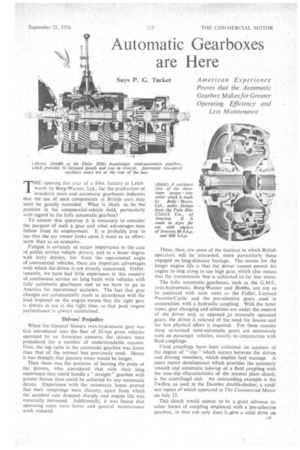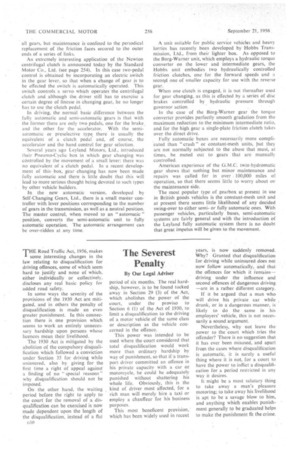Automatic Gearboxes are Here
Page 127

Page 128

If you've noticed an error in this article please click here to report it so we can fix it.
Says P. G. Tucker
THE opening this yea' of a ,E4m. factory at Letchworth by Borg-Warner, Ltd., for the production of overdrive units and automatic gearboxes indicates that the use of such components in British cars. may, soon be greatly extended. _ What is likely to. be. the, position in the commercial-vehicle field, particularly with regard to the fully automatic gearbox?
To answer this question it is necessary to consider the purpose of such a gear and what advantages may follow from its employment. It is probably true to say that the car owner looks upon it more as an effortsaver than as an economy.
Fatigue is certainly of major importance in the case of public service vehicle drivers, and to a lesser degree with lorry drivers, but from the operational angle of commercial vehicles, there are important advantages with which the driver is not directly concerned. Unfortunately, we have had little experience in this country of continuous service on long hauls with vehicles with fully automatic gearboxes and so we have to go to America for operational statistics. The fact that gear changes are automatically made in accordance with the load imposed on the engine means that the right gear is always in use at the right time, so that peak engine performance is always maintained.
Drivers' Prejudice
When theGeneral Motors twin-hydromatic gear was first introduced into the fleet of 26-ton gross vehicles operated by an American concern, the drivers were prejudiced for a number of understandable reasons. First, the top ratio in the automat4c gearbox was lower than that of the normal box previously used. Hence it was thought that journey times would be longer.
Then there was the question of hurting the pride of the drivers, who considered that with their long experience they could handle a " straight " gearbox with greater finesse than could be achieved by any automatic device. Experience with the automatic boxes proved that their misgivings were illusory, apart from which the accident rate dropped sharply and engine life was materially increased. Additionally, it was found that operating costs were lower and general maintenance work reduced. These, then, are some of the features in which British operators will be interested, more particularly those engaged on long-distance haulage. The reason for the longer engine life is that the driver cannot permit his engine to slog along in too high gear, which also means that the transmission line is subjected to far less stress.
The fully automatic gearboxes, such as the G.M.C. twin-hydromatic, Borg-Warner and Hobbs, are not to be confused with such units as the Fuller, Leyland Pneumo-Cyclic and the pre-selective gears used in conjunction with a hydraulic coupling. With the latter types, gear changing and selection are under the control of the driver and, as opposed to manually operated -gears, the driver is relieved of the need for finesse and far less physical effort is required. For these reasons these so-termed semi-automatic gears are extensively used on passenger vehicles, usually in conjunction with fluid couplings.
Fluid couplings have been criticized on account of the degree of " slip " which occurs between the driven and driving members, which implies fuel. wastage. A more recent development which provides the necessary smooth and automatic take-up of a fluid coupling with the non-slip characteristics of the normal plate clutch, is the centrifugal unit. An outstanding example is the Twiflex, as used in the Daimler double-decker, a roadtest report of which appeared in The Commercial Motor on July 13.
This clutch would appear to be a great advance on other forms of coupling employed with a pre-selective gearbox, in that not only does it:give a solid drive on 69
all gears, but maintenance is confined to the periodical replacement of the friction faces secured to the outer ends of a series of links.
An extremely interesting application of the Newton centrifugal clutch is announced today by the Standard Motor Co., Ltd. (see page 254). In this case two-pedal control is obtained by incorporating an electric switch in the gear lever, so that when a change of gear is to be effected the switch is automatically operated. This switch controls a servo which operates the centrifugal clutch and although the driver still has to exercise a certain degree of finesse in Changing gear, he no longer has to use the clutch pedal.
In driving, the normal basic difference between the fully automatic and semi-automatic gears is that with the former there are only two pedals, one for the brake_ and the other for the accelerator. With the semiautomatic or preselective type there is usually the equivalent of a clutch pedal and, of course, the accelerator and the hand control for gear selection.
Several years ago Leyland Motors, Ltd., introduced their Pneumo-Cyclic box in which gear changing was cantrolled by the movement of a small lever: there was no equivalent of a clutch pedal. In a recent development of thisbox, gear changing has now been made fully automatic and there is little doubt that this will lead to more serious thought being devoted to such types by other vehicle builders.
In the new automatic version, developed by Self-Changing Gears, Ltd., there is a small master con troller with lever positions corresponding to the number of gears in the transmission, as well as a neutral position. The master control, when moved to an " automatic " position, converts the semi-automatic unit to fully automatic operation. The automatic arrangement can be over-ridden at any time. A unit suitable for public service vehicles and heavy lorries has recently been developed by Hobbs Transmission, Ltd., from their lighter box. As opposed to the Borg-Warner unit, which employs a hydraulic torque converter on the lower and intermediate gears, the Hobbs unit embodies two hydraulically controlled friction clutches, one for the forward speeds and a secortel one of smaller capacity for use with the reverse gear.
When one clutch is engaged, it is not thereafter used for gear changing, as this is effected by a series of disc brakes controlled by hydraulic pressure through governor action.
In the case of the Borg-Warner gear the torque converter provides perfectly smooth gradation from the maximum reduction to the minimum intermediate ratio, and for the high gear a single-plate friction clutch takes over the direct drive.
Fully automatic boxes are necessarily more complicated than "crash" or constant-mesh units, but they are not normally subjected to the abuse that must, at times, be meted out to gears that are manually controlled.
American experience of the G.M.C. twin-hydromatic gear shows that nothing but minor maintenance and repairs was called for in over . 100,000 miles of operation, so that there seems little to worry about on the maintenance side.
The most popular type of gearbox at present in use in British goods vehicles is the constant-mesh unit and at present there seems little likelihood of any decided swing-over to either semior fully automatic ones. With passenger vehicles, particularly buses, semi-automatic systems are fairly general and with the introduction of the Leyland fully automatic system there is no doubt that great impetus will be given to the movement.




































































































































































































































































































































